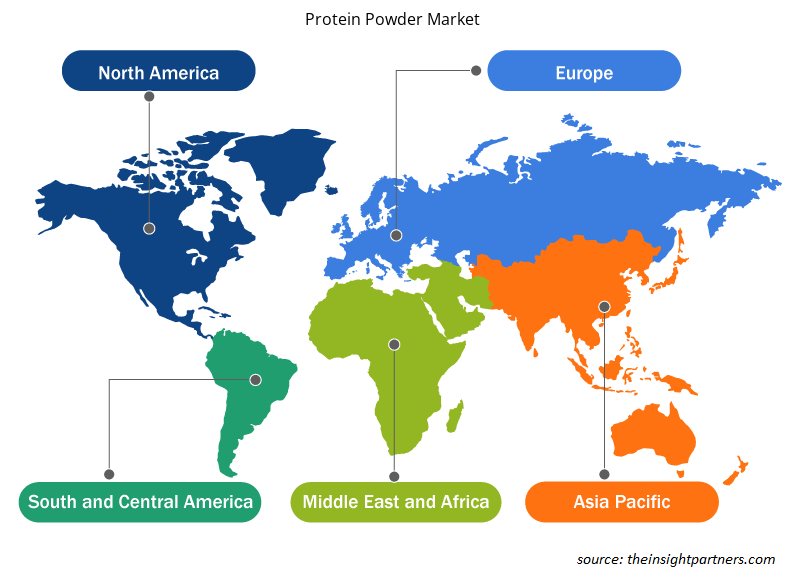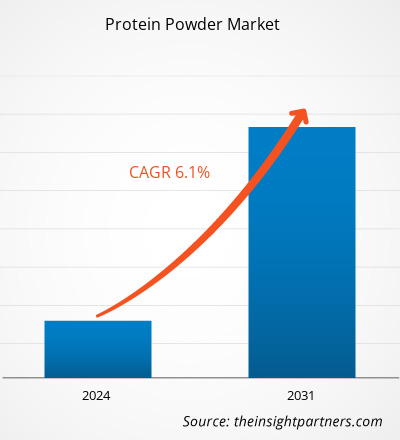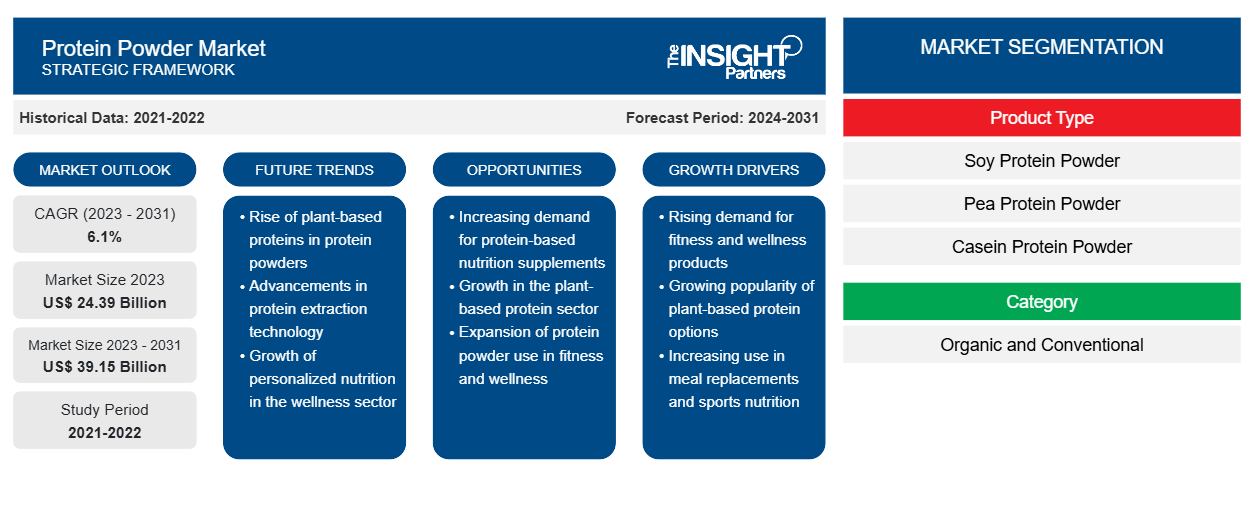Le marché des protéines en poudre devrait atteindre 39,15 milliards de dollars d'ici 2031, contre 24,39 milliards de dollars en 2023. Le marché devrait enregistrer un TCAC de 6,1 % au cours de la période 2023-2031. La demande croissante de protéines en poudre à base de plantes et la sensibilisation accrue à la santé devraient rester les principales tendances du marché.
Analyse du marché des protéines en poudre
Plusieurs facteurs clés peuvent être attribués à la demande croissante de protéines en poudre dans le monde. Tout d'abord, les avantages de la consommation de protéines en poudre ont accru la prise de conscience de l'importance des protéines dans l'alimentation. Les protéines sont constituées d'acides aminés essentiels, qui sont utiles pour la récupération et la croissance musculaire, ce qui les rend très populaires parmi les athlètes, les culturistes et les amateurs de fitness. Lorsque les gens cherchent à atteindre leurs objectifs de remise en forme , ils prennent souvent de la poudre de protéines pour répondre facilement à leurs besoins quotidiens en protéines. Deuxièmement, la demande d'alternatives aux protéines d'origine végétale a considérablement augmenté, ce qui a encore stimulé la demande de protéines en poudre. De nombreuses personnes adoptent un mode de vie à base de plantes ou végétalien, qui n'est pas satisfait par les sources de protéines conventionnelles. En conséquence, les poudres de protéines d'origine végétale, généralement dérivées de pois, de riz et de chanvre, ont gagné en popularité auprès de la population. Cette évolution vers des options à base de plantes a élargi les opportunités du marché des protéines en poudre pour répondre à une base de consommateurs plus large et plus diversifiée.
Aperçu du marché des protéines en poudre
Le marché des protéines en poudre a connu une croissance significative au cours de la période de prévision. L’Amérique du Nord est devenue l’un des principaux contributeurs à cette croissance, en raison du nombre croissant d’amateurs de fitness dans la région. En outre, la demande de protéines végétales provenant de sources telles que les microalgues et les lentilles d’eau a considérablement augmenté, tandis que l’on recherche également des emballages transparents qui répertorient clairement tous les ingrédients et leurs sources. Cette tendance signifie une évolution vers des produits plus durables et naturels, motivée par les préférences des consommateurs pour la transparence et des ingrédients reconnaissables. Elle offre aux entreprises des opportunités d’innover dans les produits et les emballages à base de protéines végétales pour répondre à ces demandes évolutives des consommateurs.
Personnalisez ce rapport en fonction de vos besoins
Vous bénéficierez d'une personnalisation gratuite de n'importe quel rapport, y compris de certaines parties de ce rapport, d'une analyse au niveau des pays, d'un pack de données Excel, ainsi que de superbes offres et réductions pour les start-ups et les universités.
- Obtenez les principales tendances clés du marché de ce rapport.Cet échantillon GRATUIT comprendra une analyse de données, allant des tendances du marché aux estimations et prévisions.
Aperçu régional du marché des protéines en poudre
Les tendances régionales et les facteurs influençant le marché des protéines en poudre tout au long de la période de prévision ont été expliqués en détail par les analystes d’Insight Partners. Cette section traite également des segments et de la géographie du marché des protéines en poudre en Amérique du Nord, en Europe, en Asie-Pacifique, au Moyen-Orient et en Afrique, ainsi qu’en Amérique du Sud et en Amérique centrale.

- Obtenez les données régionales spécifiques au marché des protéines en poudre
Portée du rapport sur le marché des protéines en poudre
| Attribut de rapport | Détails |
|---|---|
| Taille du marché en 2023 | 24,39 milliards de dollars américains |
| Taille du marché d'ici 2031 | 39,15 milliards de dollars américains |
| Taux de croissance annuel composé mondial (2023-2031) | 6,1% |
| Données historiques | 2021-2022 |
| Période de prévision | 2024-2031 |
| Segments couverts | Par type de produit
|
| Régions et pays couverts | Amérique du Nord
|
| Leaders du marché et profils d'entreprises clés |
|
Densité des acteurs du marché : comprendre son impact sur la dynamique des entreprises
Le marché des protéines en poudre connaît une croissance rapide, tirée par la demande croissante des utilisateurs finaux en raison de facteurs tels que l'évolution des préférences des consommateurs, les avancées technologiques et une plus grande sensibilisation aux avantages du produit. À mesure que la demande augmente, les entreprises élargissent leurs offres, innovent pour répondre aux besoins des consommateurs et capitalisent sur les tendances émergentes, ce qui alimente davantage la croissance du marché.
La densité des acteurs du marché fait référence à la répartition des entreprises ou des sociétés opérant sur un marché ou un secteur particulier. Elle indique le nombre de concurrents (acteurs du marché) présents sur un marché donné par rapport à sa taille ou à sa valeur marchande totale.
Les principales entreprises opérant sur le marché des protéines en poudre sont :
- Nutrition de performance Glanbia
- Iovate Health Sciences International Inc.
- Suppléments et nutrition bio-conçus Inc.
- Nutrition Dymatize
- Le groupe Hut
- Nature
Avis de non-responsabilité : les sociétés répertoriées ci-dessus ne sont pas classées dans un ordre particulier.

- Obtenez un aperçu des principaux acteurs du marché des protéines en poudre
- Analyse historique (2 ans), année de base, prévision (7 ans) avec TCAC
- Analyse PEST et SWOT
- Taille du marché Valeur / Volume - Mondial, Régional, Pays
- Industrie et paysage concurrentiel
- Ensemble de données Excel
Rapports récents
Témoignages
Raison d'acheter
- Prise de décision éclairée
- Compréhension de la dynamique du marché
- Analyse concurrentielle
- Connaissances clients
- Prévisions de marché
- Atténuation des risques
- Planification stratégique
- Justification des investissements
- Identification des marchés émergents
- Amélioration des stratégies marketing
- Amélioration de l'efficacité opérationnelle
- Alignement sur les tendances réglementaires





















 Obtenez un échantillon gratuit pour - Marché des protéines en poudre
Obtenez un échantillon gratuit pour - Marché des protéines en poudre